Copied from The Old Motor
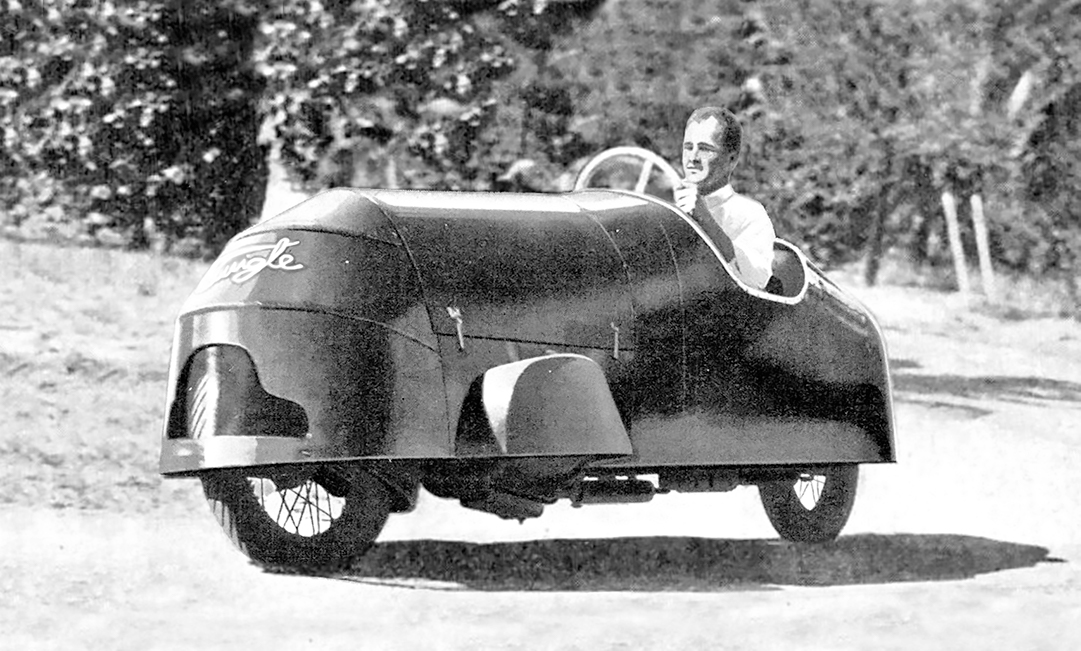
Tingle Two-Wheelers: Motorcycles, Cars, or Cyclecars?
February 17, 2021
On Valentine’s Day 1939, James Grady Tingle road tested his astonishing new Tingle two-wheeled roadster. A photographer from The Miami News stopped by a few days later to memorialize the occasion. “Why did you build it?” the shutterbug asked, perhaps anticipating a response laced with engineering principals, physical properties, and complex mathematical equations. Instead, his simple question prompted a simple answer. “Four years ago, I had an idea that a two-wheeled automobile would be useful,” Tingle said. “So, I just started building one.”
Lead image – J. Grady Tingle’s roadster balanced on two motorcycle wheels. A foot control extended retractable outriggers to keep the machine upright at low speeds.
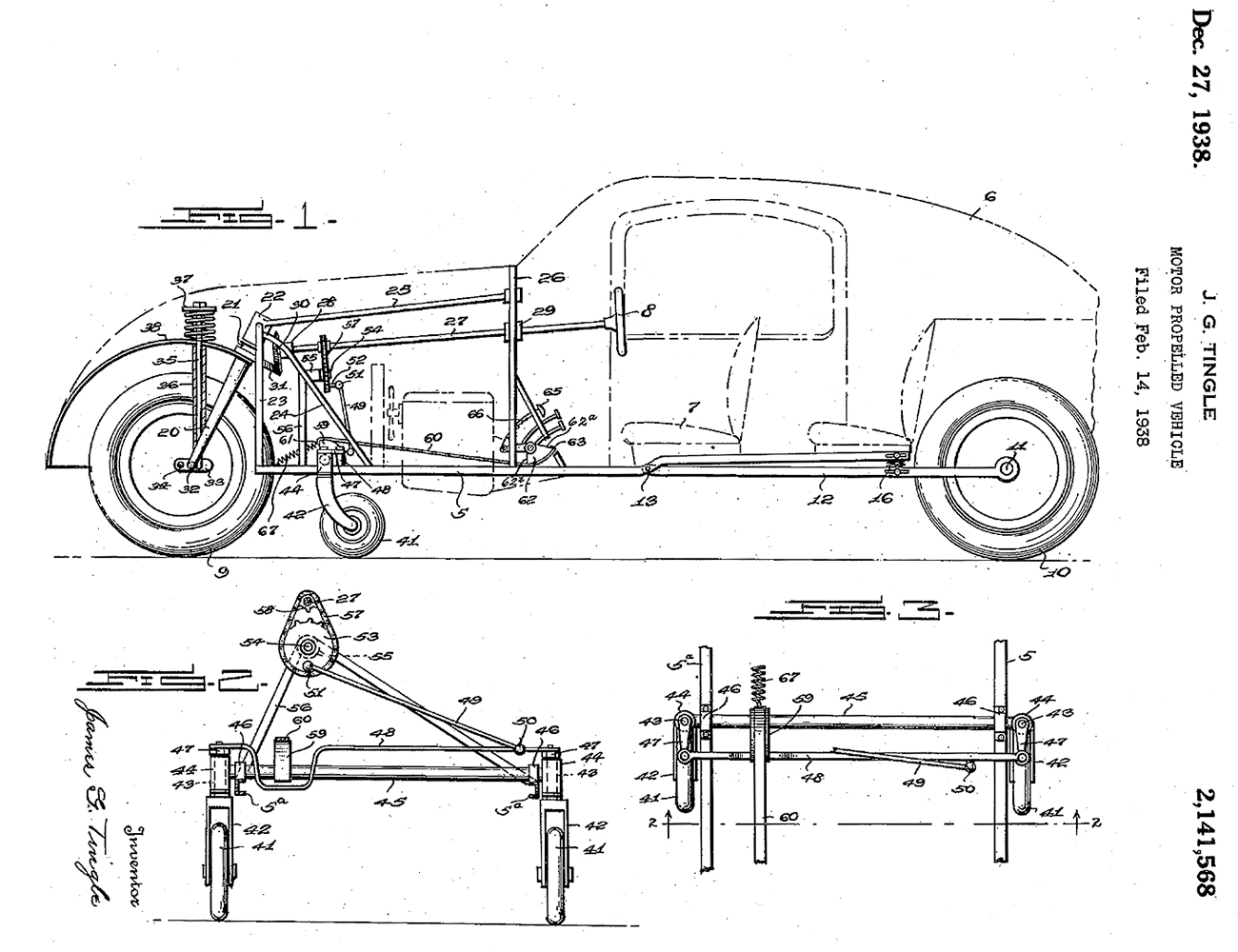
Tingle’s patent art called for a streamlined body enveloping an American Austin engine, transmission and radiator. A drive shaft transferred power to the rear wheel via bevel gear drive.
No, J. Grady Tingle, as he called himself, was no engineer. Far from it. He was born on March 11, 1892 in rural Monroe County, Georgia. As a young man, he clerked at a bank in the county seat of Forsyth. The small town offered few opportunities and by 1920, Tingle and his bride had relocated to Miami, Florida, where he partnered with R. E. Ponder in the Ponder & Tingle Paint Company. The following year, Ponder retired and sold his interest in the company to H. E. Platt, a well-connected entrepreneur who was soon to become president of the Miami Paint, Oil and Varnish Club, an organization composing 95 per cent of the wholesale and retail paint dealers of the city.
The men remodeled a modest little paint store at 122 S. Miami Avenue, as noted in The Miami News. “The cleanliness of the place is most noticeable and the firm expects to keep it so that any woman will find it as suitable a place to shop as a millinery or clothing store.” Instead of displaying paint varieties in “objectionable kegs and pails,” the Platt & Tingle Paint Company displayed dry pigments in specially constructed bins, which were similar to the tilting flour bins of the old-style kitchen cabinets. Patrons selected the powders of choice and Tingle mixed the colors by hand.
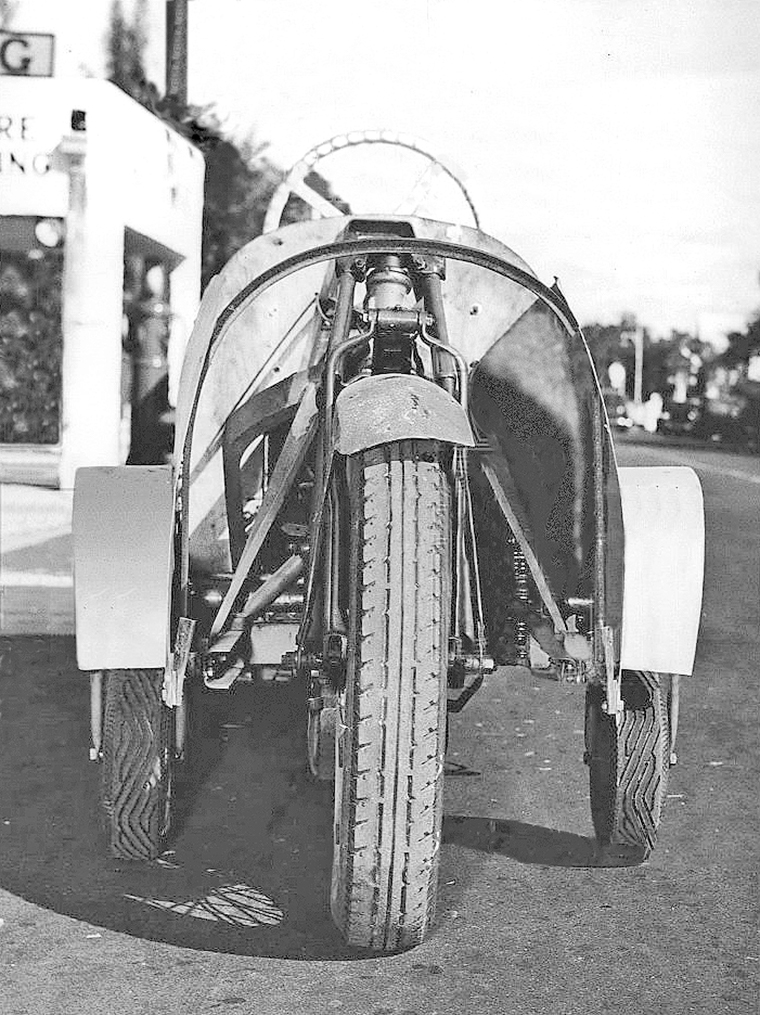
With outrigger wheels lowered, Tingles looked like tricycles when viewed from the front.
Platt & Tingle grew to be one of South Florida’s leading paint establishments and Tingle purchased Platt’s share in May 1935. It was then that he conceived of fabricating a two-wheeled automobile. The idea was highly unusual but not entirely new. In 1913, artist and newspaper heir James Scripps-Booth had fashioned an ungainly three-passenger two-wheeler dubbed the Bi-Autogo. At cruising speeds, the massive underslung automobile balanced on two heavy, wooden-spoked artillery wheels. But at slower speeds, Scripps-Booth pushed a lever to lower two pairs of small outrigger wheels that kept the machine from tipping over. Equipped with the first V-8 engine built in Detroit, the aluminum-bodied ugly duckling could easily reach speeds of 75 miles per hour. However, its 3,200-pound weight and difficult steering halted the $25,000 experiment.
In stark contrast to the Bi-Autogo, Tingle’s new Tingle roadster and Tandem sedan would be light and nimble. In the first of several patents filed between 1936 and 1939, Tingle laid out plans for a streamlined, enclosed sedan-type body with a silhouette that resembled a blend of Chrysler’s Airflow and Barney Oldfield’s Golden Submarine. The body shell would be mounted on a narrow, channel iron frame with an Indian motorcycle fork in the front and a unique rear fork that was pivotally mounted to the inner sides of the frame members.
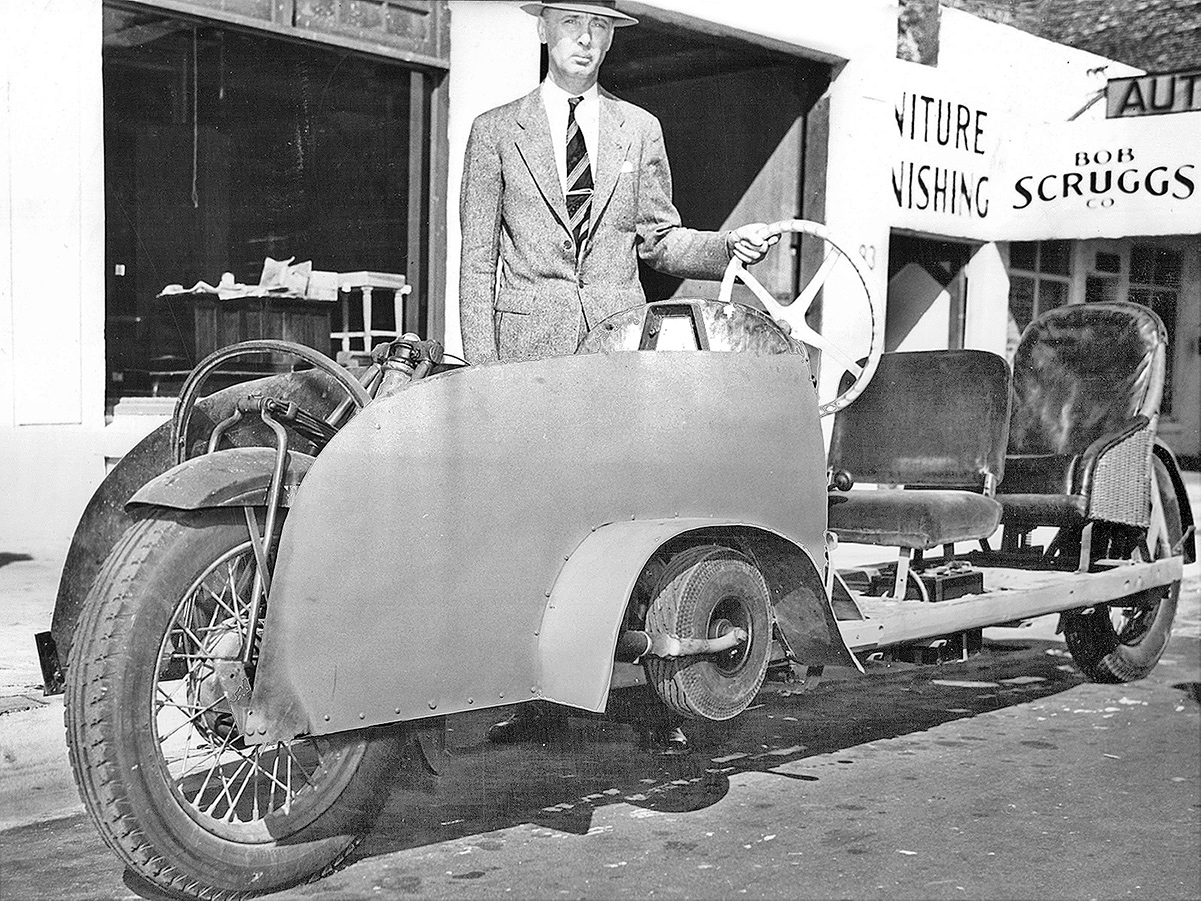
J. Grady Tingle stands beside his Tingle Tandem sedan, under construction. It resembled a stretched motorcycle with an automobile steering wheel and porch seats.
Integral were a pair of retractable outrigger wheels much like the Bi-Autogo but mounted behind the front wheel. Since the front wheel pivoted for steering, the outrigger wheels would be synchronized to also pivot by means of a sprocket on the steering column that engaged a larger sprocket and an A-frame, which contained a series of links, cranks, shanks and casters. Tingle would raise and lower the entire A-frame using a foot control.
Tingle’s patent drawing called for a compact engine nestled between the frame rails. His choice was easy, since Miami was also home to Roy S. Evans and Evans Motors, the world’s largest distributor of American Austin cars and trucks. So, Tingle acquired a stock 13-horsepower, 45 cu. in., water-cooled American Austin engine, transmission, and radiator. After first experimenting with chain drive, he incorporated a long drive shaft and two Spicer universal joints mounted six degrees to the right to transfer power from the transmission to Tingle’s patented combination bevel gear drive and braking mechanism on the rear wheel.
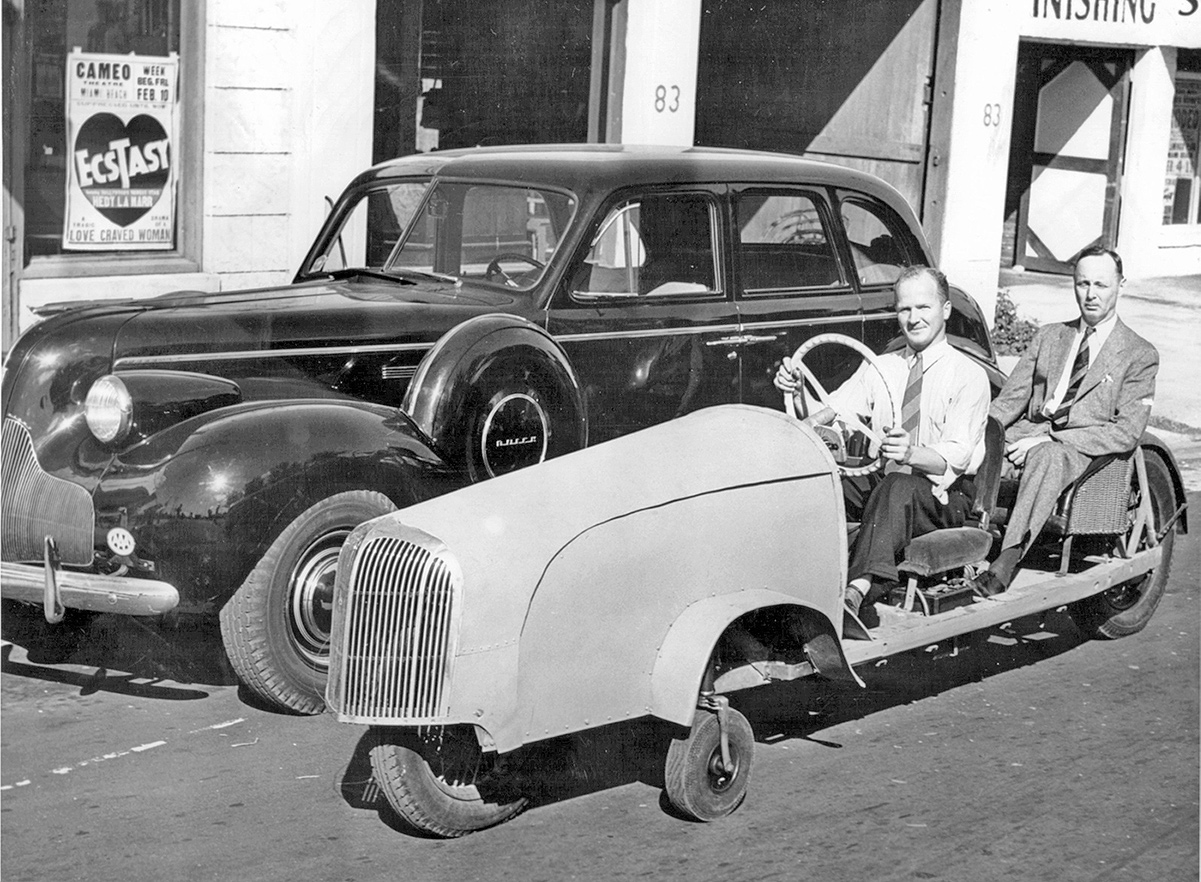
As Tingle fashioned his Tandem sedan, he discarded the Chrysler Airflow-type curved front end indicated on the patent drawing and installed a more traditionally styled vertical grille instead.
Although Tingle’s initial plan was to build the two-passenger Tandem sedan, he first completed a 650-pound, single-passenger roadster on a wheelbase of about 120 inches. He selected Valentine’s Day to road test the car to celebrate the first anniversary of his 1938 patent filing date. He was pleased with the car’s overall performance and claimed it moved smoothly through traffic at speeds of up to 70 mph. (That’s particularly notable because American Austin quoted a top speed of 45 mph for its cars and trucks.) “It’s the closest thing to flying that I’ve ever driven and yet stayed on the ground!” he exclaimed.
Tingle believed his little cars would do almost anything asked of either a motorcycle or automobile, and he envisioned commercial possibilities for businesses that predominantly used horse-drawn wagons, bicycles, and motorcycles. He said a Tingle car could be mass produced and put on the market for less than $400 and that it would deliver fuel economy of 50 mpg.
A decidedly less optimistic newspaperman warned readers that driving a Tingle would require nerves of steel. “The driver must lean inside on the curves, as though he were riding a motorcycle,” he reported. “Until this sense of balance is developed there may be grief for the Tingle jockey.” Indeed, with the driver’s feet enclosed within the body, a Tingle could easily tip over during tight maneuvers and if the driver neglected to activate the outriggers when stopping.
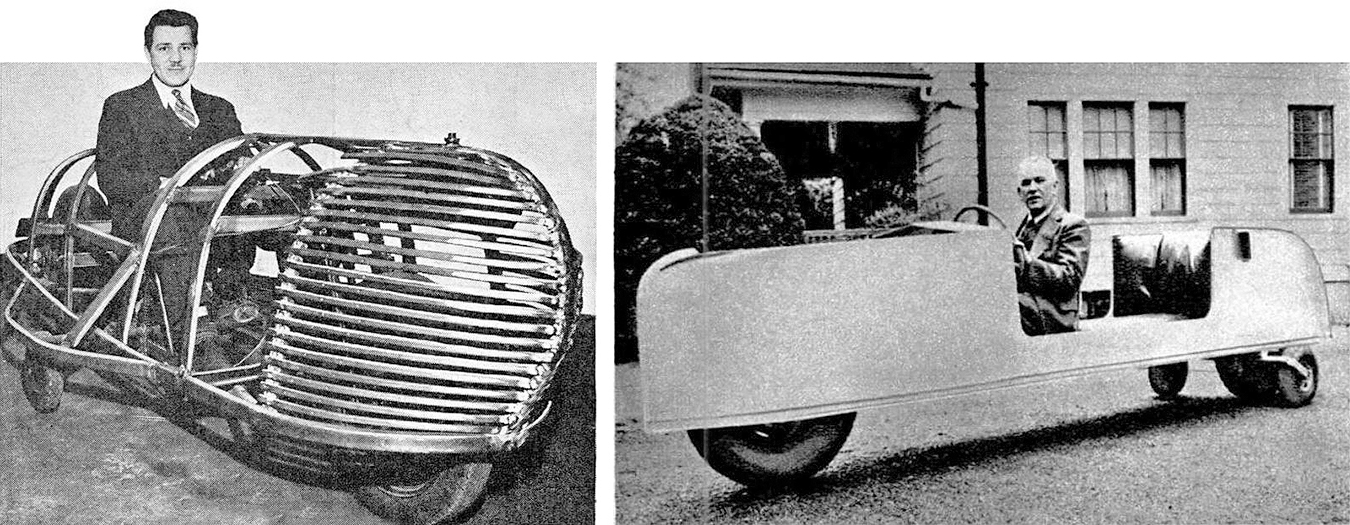
T. James Stinson, of Cleveland, Ohio, (left) and Albert A. LaPointe, of West Hartford, Connecticut, built two-wheeled automobiles inspired by Tingle’s coupe and Tandem sedan.
Undeterred, Tingle continued working on his Tingle Tandem sedan, which closely matched his patent drawings. The low-dollar contraption included a discarded automobile jump seat for the driver and a wicker porch chair for the passenger. Unlike the roadster, which had only a small grille up front to provide air flow to the radiator behind the front wheel, the sedan featured a more prominent 1930s-style passenger car grille. Although Tingle successfully shaped and installed body sheet metal from the cowl forward, it’s unclear whether he completed the rest of the metalwork.
Subsequently, more two-wheelers were created by men who believed 40-inch-wide automobiles would allow for more lanes to cure traffic congestion. Among them were T. James Stinson, of Cleveland, Ohio, who built a two-wheeled “junkmobile” with outriggers and powered by a motorcycle engine. Albert A. LaPointe, of West Hartford, Connecticut, built a three-passenger, 25-horsepower version with outriggers that lifted two inches off the pavement when the car reached a speed of 6 mph. And Tucker designer, Alex Tremulis, created the fabulous 1967 Gyro-X, which was powered by a Mini-Cooper engine and employed a high-priced gyroscope to maintain balance even when standing still.
Robert D. (Bob) Cunningham is a commercial illustrator and author of several automotive history books.

This entry was posted in Uncategorized and tagged Bi-Autogo, James Grady Tingle, Ponder & Tingle Paint Company, Scripps-Booth, Tandem sedan, Tingle roadster, Tingle two-wheelers.

Tingle Two-Wheelers: Motorcycles, Cars, or Cyclecars?
February 17, 2021
On Valentine’s Day 1939, James Grady Tingle road tested his astonishing new Tingle two-wheeled roadster. A photographer from The Miami News stopped by a few days later to memorialize the occasion. “Why did you build it?” the shutterbug asked, perhaps anticipating a response laced with engineering principals, physical properties, and complex mathematical equations. Instead, his simple question prompted a simple answer. “Four years ago, I had an idea that a two-wheeled automobile would be useful,” Tingle said. “So, I just started building one.”
Lead image – J. Grady Tingle’s roadster balanced on two motorcycle wheels. A foot control extended retractable outriggers to keep the machine upright at low speeds.

Tingle’s patent art called for a streamlined body enveloping an American Austin engine, transmission and radiator. A drive shaft transferred power to the rear wheel via bevel gear drive.
No, J. Grady Tingle, as he called himself, was no engineer. Far from it. He was born on March 11, 1892 in rural Monroe County, Georgia. As a young man, he clerked at a bank in the county seat of Forsyth. The small town offered few opportunities and by 1920, Tingle and his bride had relocated to Miami, Florida, where he partnered with R. E. Ponder in the Ponder & Tingle Paint Company. The following year, Ponder retired and sold his interest in the company to H. E. Platt, a well-connected entrepreneur who was soon to become president of the Miami Paint, Oil and Varnish Club, an organization composing 95 per cent of the wholesale and retail paint dealers of the city.
The men remodeled a modest little paint store at 122 S. Miami Avenue, as noted in The Miami News. “The cleanliness of the place is most noticeable and the firm expects to keep it so that any woman will find it as suitable a place to shop as a millinery or clothing store.” Instead of displaying paint varieties in “objectionable kegs and pails,” the Platt & Tingle Paint Company displayed dry pigments in specially constructed bins, which were similar to the tilting flour bins of the old-style kitchen cabinets. Patrons selected the powders of choice and Tingle mixed the colors by hand.

With outrigger wheels lowered, Tingles looked like tricycles when viewed from the front.
Platt & Tingle grew to be one of South Florida’s leading paint establishments and Tingle purchased Platt’s share in May 1935. It was then that he conceived of fabricating a two-wheeled automobile. The idea was highly unusual but not entirely new. In 1913, artist and newspaper heir James Scripps-Booth had fashioned an ungainly three-passenger two-wheeler dubbed the Bi-Autogo. At cruising speeds, the massive underslung automobile balanced on two heavy, wooden-spoked artillery wheels. But at slower speeds, Scripps-Booth pushed a lever to lower two pairs of small outrigger wheels that kept the machine from tipping over. Equipped with the first V-8 engine built in Detroit, the aluminum-bodied ugly duckling could easily reach speeds of 75 miles per hour. However, its 3,200-pound weight and difficult steering halted the $25,000 experiment.
In stark contrast to the Bi-Autogo, Tingle’s new Tingle roadster and Tandem sedan would be light and nimble. In the first of several patents filed between 1936 and 1939, Tingle laid out plans for a streamlined, enclosed sedan-type body with a silhouette that resembled a blend of Chrysler’s Airflow and Barney Oldfield’s Golden Submarine. The body shell would be mounted on a narrow, channel iron frame with an Indian motorcycle fork in the front and a unique rear fork that was pivotally mounted to the inner sides of the frame members.

J. Grady Tingle stands beside his Tingle Tandem sedan, under construction. It resembled a stretched motorcycle with an automobile steering wheel and porch seats.
Integral were a pair of retractable outrigger wheels much like the Bi-Autogo but mounted behind the front wheel. Since the front wheel pivoted for steering, the outrigger wheels would be synchronized to also pivot by means of a sprocket on the steering column that engaged a larger sprocket and an A-frame, which contained a series of links, cranks, shanks and casters. Tingle would raise and lower the entire A-frame using a foot control.
Tingle’s patent drawing called for a compact engine nestled between the frame rails. His choice was easy, since Miami was also home to Roy S. Evans and Evans Motors, the world’s largest distributor of American Austin cars and trucks. So, Tingle acquired a stock 13-horsepower, 45 cu. in., water-cooled American Austin engine, transmission, and radiator. After first experimenting with chain drive, he incorporated a long drive shaft and two Spicer universal joints mounted six degrees to the right to transfer power from the transmission to Tingle’s patented combination bevel gear drive and braking mechanism on the rear wheel.

As Tingle fashioned his Tandem sedan, he discarded the Chrysler Airflow-type curved front end indicated on the patent drawing and installed a more traditionally styled vertical grille instead.
Although Tingle’s initial plan was to build the two-passenger Tandem sedan, he first completed a 650-pound, single-passenger roadster on a wheelbase of about 120 inches. He selected Valentine’s Day to road test the car to celebrate the first anniversary of his 1938 patent filing date. He was pleased with the car’s overall performance and claimed it moved smoothly through traffic at speeds of up to 70 mph. (That’s particularly notable because American Austin quoted a top speed of 45 mph for its cars and trucks.) “It’s the closest thing to flying that I’ve ever driven and yet stayed on the ground!” he exclaimed.
Tingle believed his little cars would do almost anything asked of either a motorcycle or automobile, and he envisioned commercial possibilities for businesses that predominantly used horse-drawn wagons, bicycles, and motorcycles. He said a Tingle car could be mass produced and put on the market for less than $400 and that it would deliver fuel economy of 50 mpg.
A decidedly less optimistic newspaperman warned readers that driving a Tingle would require nerves of steel. “The driver must lean inside on the curves, as though he were riding a motorcycle,” he reported. “Until this sense of balance is developed there may be grief for the Tingle jockey.” Indeed, with the driver’s feet enclosed within the body, a Tingle could easily tip over during tight maneuvers and if the driver neglected to activate the outriggers when stopping.

T. James Stinson, of Cleveland, Ohio, (left) and Albert A. LaPointe, of West Hartford, Connecticut, built two-wheeled automobiles inspired by Tingle’s coupe and Tandem sedan.
Undeterred, Tingle continued working on his Tingle Tandem sedan, which closely matched his patent drawings. The low-dollar contraption included a discarded automobile jump seat for the driver and a wicker porch chair for the passenger. Unlike the roadster, which had only a small grille up front to provide air flow to the radiator behind the front wheel, the sedan featured a more prominent 1930s-style passenger car grille. Although Tingle successfully shaped and installed body sheet metal from the cowl forward, it’s unclear whether he completed the rest of the metalwork.
Subsequently, more two-wheelers were created by men who believed 40-inch-wide automobiles would allow for more lanes to cure traffic congestion. Among them were T. James Stinson, of Cleveland, Ohio, who built a two-wheeled “junkmobile” with outriggers and powered by a motorcycle engine. Albert A. LaPointe, of West Hartford, Connecticut, built a three-passenger, 25-horsepower version with outriggers that lifted two inches off the pavement when the car reached a speed of 6 mph. And Tucker designer, Alex Tremulis, created the fabulous 1967 Gyro-X, which was powered by a Mini-Cooper engine and employed a high-priced gyroscope to maintain balance even when standing still.
Robert D. (Bob) Cunningham is a commercial illustrator and author of several automotive history books.

This entry was posted in Uncategorized and tagged Bi-Autogo, James Grady Tingle, Ponder & Tingle Paint Company, Scripps-Booth, Tandem sedan, Tingle roadster, Tingle two-wheelers.
Comment